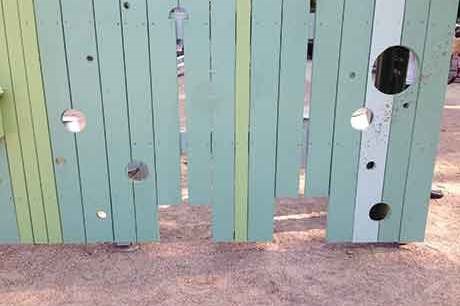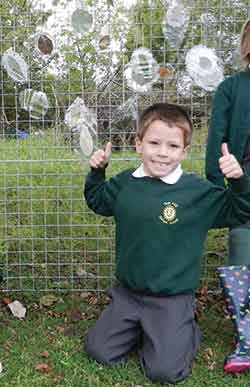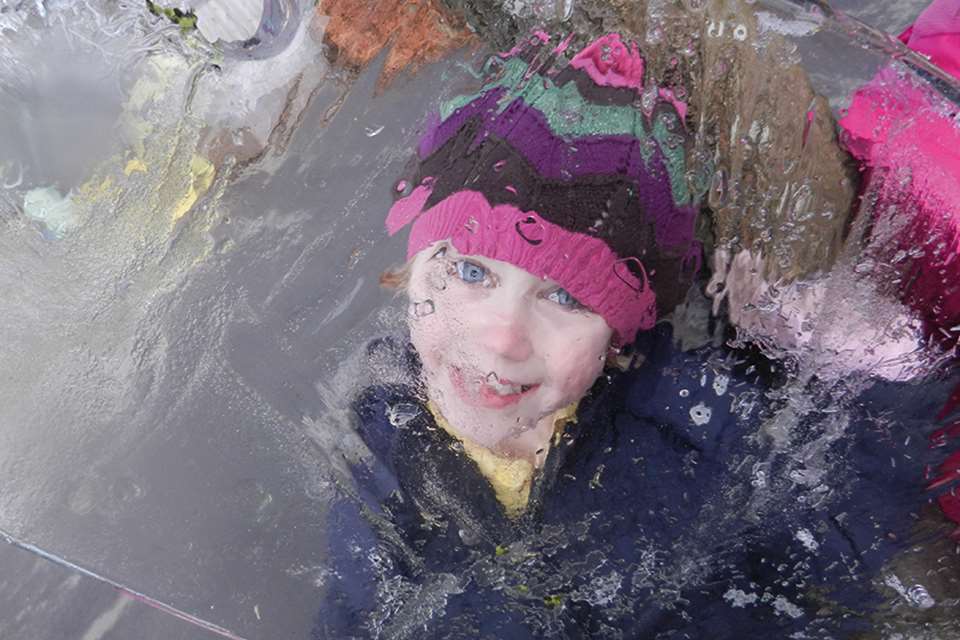EYFS Activities: Five things to do with...your fences
Julie Mountain
Monday, February 20, 2017
Every outdoor fixture should work hard for its keep – including fences. By Julie Mountain

1: Weaving
Fence weaving is simple and can transform the dullest fence into a work of art. Weaving is a familiar activity in most settings, with clear benefits for the development of children’s creativity as well as their fine motor skills. Fence weaving takes it a step further, combining whole body movements (reaching up, stretching across, bending down, pulling through) with those more delicate actions.
Try weaving strips of colourful plastic bags, strips of fabric (ask for sheet, shirt or towel donations from parents), thin willow twigs, long craft straws, colourful string or wool, wide ribbons or seasonal grasses and flowers.
An internet ‘image’ search will bring up hundreds of ideas for materials, patterns and pictures; also check out Pinterest, where you can also store your own ideas.
2: Peepholes
Close-boarded fences can make early years spaces feel rather enclosed, especially when you consider how tall they can seem to small children. Reconnect your children with their neighbourhood by creating peepholes or portholes in strategic places along the fence. This idea works equally well within a school or setting where fences have been used to separate outdoor spaces. Spying on the ‘big children’ through a peephole is enormous fun.
Choose a variety of heights, sizes and shapes, and mark them out with chalk. Begin each peephole by drilling through the fence with the widest drill bit you have, then use a jigsaw to cut around the shape you’ve chalked. Remove any splinters and sand-smooth the exposed edges.
3: Art gallery If your fence can handle the weight, convert it into an art gallery. Collect old picture frames and carefully remove and dispose of the glass. Charity shops, jumble and car boot sales, amenity tips and parental donations are good places to look for a variety of interesting and quirky frames. If the frames don’t already have eye-hooks on the back, screw small stainless steel ones into the back and use cable ties or string to attach the frame securely to the fence.
If your fence can handle the weight, convert it into an art gallery. Collect old picture frames and carefully remove and dispose of the glass. Charity shops, jumble and car boot sales, amenity tips and parental donations are good places to look for a variety of interesting and quirky frames. If the frames don’t already have eye-hooks on the back, screw small stainless steel ones into the back and use cable ties or string to attach the frame securely to the fence.
Laminate children’s artworks, leaving a very wide laminate border all the way around so that rain is less likely to seep in and ruin the picture. Place the laminated pictures into the frames, sticking them down with duct tape.
You could also insert plastic mirrors and whiteboards into a few of the picture frames. Keep a pot of dry-wipe markers nearby to encourage children to draw self-portraits, or just mark-make when they feel the need.
4: Dens
Fences make excellent ‘launch points’ for dens. A truly simple starter is to attach two corners of a large tarpaulin or brightly coloured king-sized sheet at adult head height. The other two corners can be pegged or weighed down (if necessary), leaving a triangular tent shape, perfect for colonising with cushions, small-world resources or storybooks.
Use good-quality carabiners to attach den-making resources to the fence. They are secure, easy and quick for adults to manipulate, but tricky for small hands.
Extend a simple den by tying the other two corners to tent poles and pushing them into the ground. Tent pegs (thin metal) and tarp pegs (plastic with wide tops) can be bought at pound shops and it’s worth having a boxful of these, along with a few clothes pegs, twist-tie hair curlers and bag clips so that children can extend their den independently.
5: Performance space
Tie blank sheets of sugar paper or wallpaper lining to the fence and provide large-scale mark-making materials such as paintbrushes, rollers, sponges and water sprayers (these make excellent ‘airbrushes’). Ask children to create a backdrop for a performance (or story) – for example, a castle with a dragon, a seaside scene, an alien planet, the jungle.
Chalk a performance area onto the ground (or use string or rope) and provide dressing-up clothing, loose parts and small-world resources.
It might take a few attempts before children ‘get’ this idea – but it’s worth persevering, because as soon as it clicks they will love having their own ever-changing theatre.
Benefit-risk assessment
Key questions to consider:
- What condition are your fences in? Are there any gaps, splinters or loose wires?
- What are they made from? Depending on the location, fences might consist of formal ironwork, galvanised or plastic-coated steel mesh, or informal timber styles such as chestnut palings or more formal sawn and planed timber.
- Check the load-bearing capacity of your fences before embarking on a project. Are your fences strong enough to bear the weight of, for example, a noticeboard, plastic guttering for marble runs, or a clambering child?





